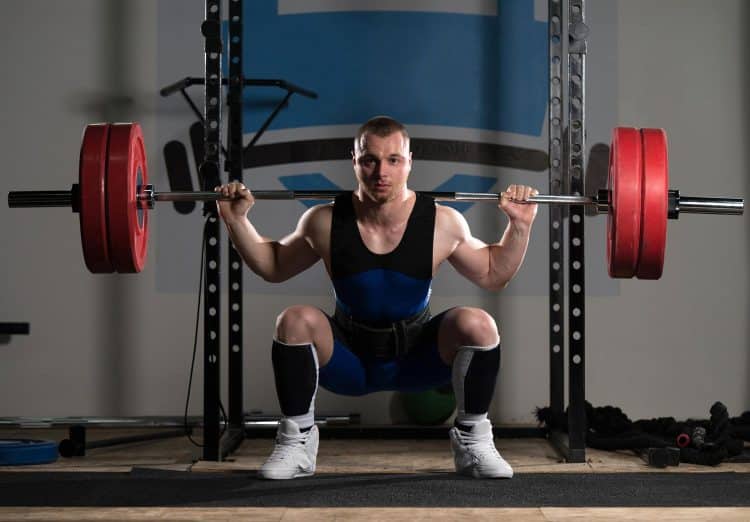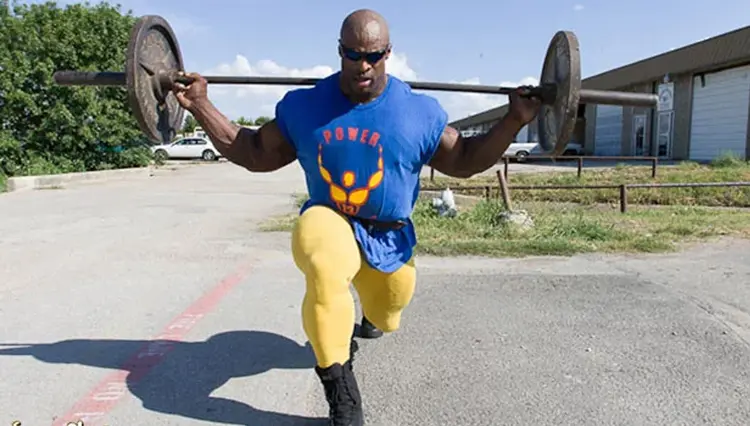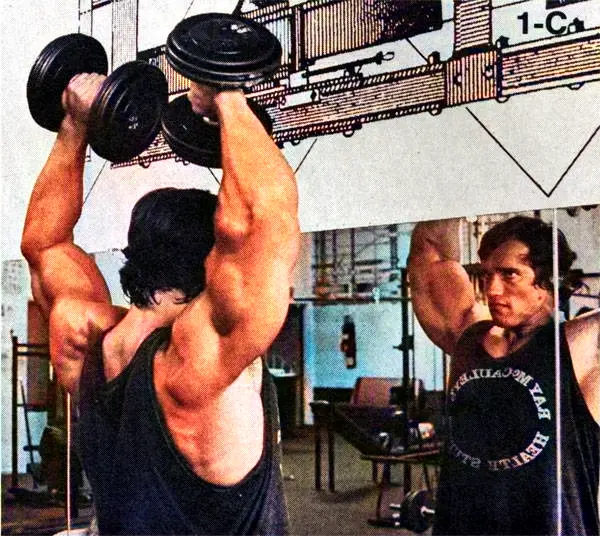Most training programs are built around what are typically called straight sets. This means doing things like three sets of ten or four sets of eight. Straight sets are the cornerstone of most bodybuilding workouts. They’re like the meat and potatoes of a mass-building meal!
However, as reliable as straight sets can be, your progress may eventually stall if that’s all you ever do.
That’s because your body is the master of adaptation. Do the same thing often enough, and it will stop responding to the demands of your workout. That’s why intelligent bodybuilders change their workouts periodically and use different set and rep schemes from time to time.
Another way to add variety and increase the intensity of your workouts is by using training systems, such as supersets, trisets, and giant sets.
In this article, we explain what giant sets are, guidelines for their use, their benefits, and drawbacks, and provide you with some examples for each major muscle group.
What Are Giant Sets?
Where supersets group two exercises together, and trisets use three, giant sets involve doing four or more exercises back-to-back for the same muscle group. You can put as many exercises as you wish in a giant set, but, for practicality, 4-6 exercises are usually about right.
Level Up Your Fitness: Join our 💪 strong community in Fitness Volt Newsletter. Get daily inspiration, expert-backed workouts, nutrition tips, the latest in strength sports, and the support you need to reach your goals. Subscribe for free!
Giant sets let you hit your muscles from several different angles, extend your time under tension, and train beyond failure, all of which can help you pull the trigger on new muscle growth.
Needless to say, giant sets are much more challenging than straight sets and are best left to experienced, well-conditioned exercisers looking to push themselves to the limit.
If that sounds like you, you will probably LOVE intensity-boosting, pump-inducing giant sets!
In general, the exercises in giant sets are done with little or no rest in between. In practical terms, this means your only recovery is the time it takes to move from one movement to the next. Slower transitions between exercises will allow you to partially recover, which will make your giant set less intense and, therefore, less effective.
Here’s an example leg giant set:
- Barbell squat 8 reps
- Leg press 10 reps
- Lunges 12 reps
- Leg extensions 12 reps
- Leg curls 12 reps
- Goblet squat 15 reps
Rest for 2-3 minutes and then repeat as required.
Giant Sets Advantages and Benefits
Are Giant sets worth adding to your workouts? Will giant sets turn YOU into a giant? Consider these benefits and then decide!
More training in less time
Look at the average bodybuilding program, and you’ll quickly realize that you actually spend longer resting than you do training. Needless to say, this is a massive waste of your valuable training time.
With giant sets, you don’t get to rest between exercises, which can be a real time saver. Giant sets allow you to cram more training into less time, so you can either do more sets per workout or just make your workouts shorter.
Hit your muscles from multiple angles
Giant sets invariably involve different exercises, training tools, and joint angles. All this variety adds up to a more productive workout.
According to the theory of neuromuscular matching, different exercises involve different groups of muscle fibers (2). So, if you want to develop a muscle to its fullest potential, you should train it with a variety of movements. Giant sets are one way to do this.
Get a good workout without heavy weights
There is no denying that heavy weights are best for building strength, but light weights can build muscle, providing you take your sets to within a few reps of failure (1). Giant sets hit your muscles with a lot of volume and are guaranteed to push you close enough to failure to build muscle, even if you are limited to training with low loads.
Get a great pump
When you do any exercise, blood is preferentially driven into that area. The blood vessels dilate or expand to allow even more blood to enter the muscle, and you experience a phenomenon called a pump.
Doing several exercises for the same muscle without a break will shunt even more blood into the area, and your pump will be even more intense.
A good pump is emotionally satisfying as it makes your muscles look bigger and fuller. However, a pump may also help increase muscle growth by stretching the fascia surrounding the muscle and force-feeding the muscle cells with nutrients. A pump may also increase the production of growth hormone, testosterone, and other critical anabolic hormones (3).
Workout variety
Giant sets are the polar opposite of what most people do during their workouts. Switching from straight sets to giant sets could be the stimulus your muscles need to grow. Giant sets will come as a massive shock to your entire neuromuscular system!
Increased cardiovascular impact
Doing several exercises without back-to-back will increase your heart rate, especially if you perform compound exercises for large muscle groups. If you want to get fit and burn a lot of calories during your workout for faster fat loss, giant set training could help.
Rescue a poor workout
We all have days where our workouts feel off. Maybe you didn’t sleep well the night before, are feeling stressed or distracted, or just can’t feel your muscles working as they should.
Giant sets are a foolproof way to turn a lousy workout into a productive one. Simply doing several exercises back-to-back means you’ll fatigue the target muscle by hitting it with a ton of volume. You don’t even need to train heavy.
So, the next time you have an off day, train your muscles with a few giant sets and then call it a day. You’ll find some tried and tested examples toward the end of this article.
Giant Set Drawbacks
Giant sets can be very effective, but they’re not without drawbacks. Consider the following downsides before adding giant sets to your bodybuilding workouts.
Monopolizing workout equipment
While this drawback is a non-issue if you train in a home or garage gym, doing giant sets in a commercial gym could make you very unpopular with your fellow exercisers.
For giant sets to work, you’ll need to monopolize several pieces of training equipment, and, in a crowded gym, that could upset the other users. You may even reach your next exercise only to find someone else is using it, and your giant set workout starts to fall apart.
So, when planning your own giant sets, try to use the same piece of equipment for multiple exercises, e.g., preacher curls followed by reverse barbell curls, regular barbell curls, and cheat curls.
Cardiovascular fatigue limits your giant set performance
Moving quickly from one exercise to another with no rest will tax your cardiovascular system. If you get too out of breath, you could find that your exercise performance declines. Not because of muscular fatigue but because your cardiovascular system cannot keep up.
If this happens, you may be unable to finish your giant set, or you could end up doing fewer reps and not stimulating your muscles sufficiently.
One way around this is to include easier isolation exercises in your giant set that will act as an active recovery.
Lower training weights
Giant sets will reduce the amount of weight you can lift in the subsequent exercises. That’s not too much of an issue when you are training for endurance or even hypertrophy, as workout intensity will still be higher.
But, if you are training for strength, a reduction in weight could make your workouts less effective. Giant sets are NOT a viable training method when building strength is your primary goal.
Overtraining
Giant sets allow you to cram a lot more training volume into less time. While that’s an obvious advantage, especially when you are in a hurry, it could be a disadvantage too. In theory, you could do several times the volume in the same training session, putting a lot more stress on your muscles and your ability to recover between workouts.
Take care to consider your rest and recovery needs with giant sets, especially if you use them to increase training volume rather than make your workouts shorter.
Level Up Your Fitness: Join our 💪 strong community in Fitness Volt Newsletter. Get daily inspiration, expert-backed workouts, nutrition tips, the latest in strength sports, and the support you need to reach your goals. Subscribe for free!
No time to stop and chat
Giant sets involve moving quickly from one exercise to the next. Taking longer than a few seconds for your transitions could make this training method less effective.
That means you may have to fend off other gym users who want to chat with you between exercises, and that could appear rude. Wearing headphones can help prevent unwanted conversations. Also, if you are the sort of person who likes to stop and talk between exercises, you may find giant sets less enjoyable.
Require careful planning – exercise order matters!
While you could just do any 4-6 exercises back-to-back and call it a giant set, you’ll get better results if you think about your choice of exercises and their order.
For example, it’s generally best to do the most demanding exercise first and then decrease the technical difficulty and intensity of the subsequent exercises. This will allow for accumulating fatigue. For example, you may want to go from freeweight to machine exercises, or compound to isolation for the same reason.
Regardless, a poorly-designed giant set could be incompletable, so it pays to plan them carefully and use conservative loads and rep targets until you are familiar with this intense training method.
It’s better to start light and easy and increase the intensity for your next giant set than to be beaten submission and have to end your workout prematurely.
Sample Giant Sets
Do you want to try giant sets for yourself but aren’t sure where to start? Take your workouts to the next level with the following examples!
Please note that while we’ve included a rep range for each giant set, this is for illustration purposes only. The actual number of reps performed will depend on how tired your muscles are and will probably decrease from one giant set to the next.
Just push each exercise to the brink of failure, and you’ll trigger hypertrophy, even if you go outside the accepted 6-12 rep range for bodybuilding. Studies suggest that intensity is far more important than a specific rep range or time under tension for muscle growth (1).
Rest 2-3 minutes between giant sets, and run through each giant set 2-4 times.
Note: Remember to move quickly from one exercise to another. There is no need to rush, but you shouldn’t dawdle, either. 10-20 seconds is ideal.
This may mean you need to move your training equipment closer together or that some giant sets are impractical in your gym because the specified machines or weight stations are too far apart. Use more accessible exercises if necessary.
1. Leg giant set
Giant sets were made for leg training! Moving from exercise to exercise means you can vary the intensity and movement pattern and keep your legs working for several minutes straight, building unstoppable endurance. A couple of laps of this giant set will exhaust your quads and hamstrings in 20 minutes or less.
- Barbell back squat 6-10 reps
- Walking lunge 10-12 reps per leg
- Leg extensions 12-15 reps
- Leg curls 12-15 reps
- Squat jumps 6-10 reps
2. Chest giant set
Monday is chest day in most gyms around the world. Pump your pecs to the limit with this chest-centric giant set.
- Incline barbell bench press 6-10 reps
- Dumbbell bench press 8-10 reps
- Pec deck 10-12 reps
- Push-ups to failure
3. Back giant set
This giant set combines vertical and horizontal pulls to build back thickness and width. Then, to finish off your lats, there’s a final lat isolation exercise so you can work without your biceps limiting your performance.
- Pull-ups to failure
- Seated close grip cable row 8-10 reps
- Lat pulldown 10-12 reps
- Chest supported dumbbell row 10-12 reps
- Straight arm cable pulldown 12-15 reps
4. Shoulders giant set
Hit your anterior, medial, and posterior deltoids and develop 3D shoulders and hulking traps with this four-exercise giant set.
- Dumbbell Arnold press 8-10 reps
- Cable face pull 10-12 reps
- Cable lateral raise 10-12 reps
- Cable upright row 12-15 reps
5. Biceps giant set
Four exercises in a row for the biceps is probably overkill, but who doesn’t like a massive arm pump? Two laps of this giant set should be enough for most people.
- Barbell preacher curl 6-8 reps
- Barbell reverse curl 8-10 reps
- Barbell biceps curl 8-10 reps
- Alternating dumbbell curl 10-12 reps (per arm)
6. Triceps giant set

As with the biceps, four back-to-back triceps exercises are probably overkill for most people. That said, it’s fun to challenge your muscles occasionally with a brutally intense workout.
- Close grip bench press 6-8 reps
- Reverse grip triceps pushdowns 8-10 reps
- Triceps pushdowns 8-10 reps
- Diamond push-ups to failure
7. Abs and core giant set
This giant set hits your midsection from every angle. Instead of doing each exercise for a specific number of reps, you will do each movement for a set time. For the planks, contract the target muscles as hard as possible, so they fail just as the time runs out. For the reverse and regular crunches, just crank out as many reps as possible in the time allowed.
- Plank 30 seconds
- Reverse crunches 30 seconds
- Side plank (left) 30 seconds
- Side plank (right) 30 seconds
- Reverse plank 30 seconds
- Crunches 30 seconds
Giant Set FAQs
1. Are giant sets good for building muscle?
That’s exactly what they’re good for! Giant sets dramatically increase workout volume and intensity, which are essential drivers of hypertrophy.
If you are used to doing moderate volume workouts, switching to giant sets will help get you out of your current workout rut and back on the gains train. Use giant sets to shock your muscles back into growth.
2. Do Giant sets build strength?
Yes, but only to a certain degree. In general, the weights are too light to develop true strength and won’t have much of an impact on your one-repetition maximum or 1RM. That type of strength is best developed with low reps and heavy weights.
However, all forms of resistance training will build some strength, even when it’s moderate loads, higher reps, and lots of volume, like with giant sets. That said, if you want to be strong like a powerlifter, that’s how you need to train.
3. How long should I do giant sets?
Like all workout intensifying training systems, giant sets work best when you use them for a short time – say 2-4 weeks. Longer than this could lead to overtraining. For example, bodybuilders tend to use giant sets for peaking, i.e., getting into optimal shape before a meet. The rest of the time, they mainly rely on straight sets.
Use giant sets to bring your current training block to a close before deloading for a week and then gradually building up training intensity and volume again over the course of your next training block.
4. Are giant sets good for fat loss?
You can definitely use giant sets for losing fat and getting leaner. Doing several back-to-back exercises will increase caloric expenditure, enhancing fat loss if you are on a calorie-restricted diet.
However, if you have cut your calories, take care not to do so many giant sets that you become overtrained. For example, you may need to dial back your training volume if you cannot recover between workouts.
How do you know you aren’t recovering? The most obvious indicator would be you are getting weaker instead of stronger from one workout to the next.
5. What type of workout should I follow with giant sets?
Giant sets work best when used as part of a split routine, where you train different muscles on different days. For example:
- Monday: Chest and back
- Tuesday: Legs
- Wednesday: Shoulders and arms
- Thursday: Chest and back
- Friday: Legs
- Saturday: Shoulders and arms
- Sunday: Rest
However, because giant sets are so voluminous and intense, it’s probably best not to use them every time you train. So, if you train your chest twice a week, do one workout with giant sets and one with straight sets to avoid overtraining.
An alternative method would be just to use giant sets for any lagging body parts. You do not have to use giant sets for your entire body if your muscles are still growing well using straight sets.
Giant Sets – Wrapping Up
If you train in a busy gym, giant sets may be impractical or inconvenient because you’ll need to hog several pieces of training equipment. But, if your gym is well-equipped and not too busy, giant sets are an excellent method for getting a lot of work done in a short amount of time. They’ll drive the intensity of your workout through the roof!
However, while giant sets are effective for building muscle, endurance, and general conditioning, they’re not so useful for developing maximal strength, where heavy weights, low reps, and long rests are the order of the day.
References:
1- PubMed: Effects of different intensities of resistance training with equated volume load on muscle strength and hypertrophy https://pubmed.ncbi.nlm.nih.gov/29564973/
2- PubMed: Activity-dependent neurotransmitter-receptor matching at the neuromuscular junction https://pubmed.ncbi.nlm.nih.gov/17190810/
3- PubMed: The mechanisms of muscle hypertrophy and their application to resistance Training https://pubmed.ncbi.nlm.nih.gov/20847704/














